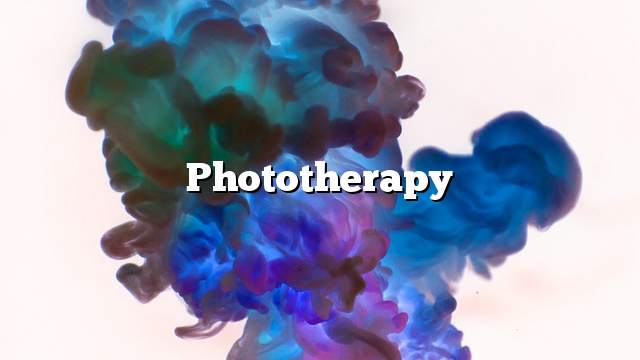Phototherapy
Phototherapy or light therapy is one of the safe treatments used in the treatment of many mental and skin diseases. The principle of the work of light therapy when used in the treatment of mental illness is the use of a device called optical therapy box, so that the box is placed next to the patient during the session The treatment emits a light that is similar to light in nature, but when treating skin conditions, devices that are capable of producing ultraviolet radiation are used more intensely than those produced by the sun.
Preparation for phototherapy
Before starting photosynthesis, the patient should tell the doctor about the health conditions he is suffering from, especially eye diseases. He should also inform the doctor about the drugs he is taking. Some medicines may cause burns in the skin if the patient is exposed to light, The patient is advised to:
- Do not apply any ointments or cosmetics, especially aromatic ones, or those containing the tar tar.
- Apply sunscreen on face and hands before starting a phototherapy session.
- Coverage of male genitalia during phototherapy session.
- Avoid exposure to the sun as much as possible, and if forced to do so; skin must be covered.
- Avoid foods that increase the body’s sensitivity to UV rays, such as foods containing psoralen (carrots, celery, figs, citrus, parsley, etc.).
Diseases treated with phototherapy
psychological diseases
The use of light therapy in the treatment of some psychological problems, and because of its safety and limited side effects, it is recommended for use by specialists, especially in the stages of pregnancy and lactation, and cases of depression that do not want the patient to take medicine, or cases of depression and mental illness, which require psychological sessions to reach the patient to the patient goal The desired treatment, and the health problems that can be used for phototherapy include:
skin diseases
Ultraviolet light helps to treat skin diseases such as psoriasis by slowing the process of doubling the skin cells by inhibiting the formation of DNA. It also helps to treat eczema by changing the function of immune cells in the skin. Skin-sensitive conditions Ultraviolet rays can help treat them by increasing the darkening and thickening of the skin, reducing the amount of radiation that passes through the skin, and other skin diseases that phototherapy plays an important role in treating it ::
- Psoriasis.
- Vitiligo.
- General itching.
- Some cancers of the lymph nodes.
- Pityriasis is a type of temporary skin rash that appears on the skin.
- Dermatitis, especially atopic dermatitis.
Side effects of phototherapy
Phototherapy can lead to some minor temporary side effects, including:
- Redness of the skin where phototherapy.
- Rash onset.
- Itching.
- skin dryness.
- Cold sores.
- Blisters.
- Eyestrain.
- Sense of headache.
- Irritation.
- Nausea.
- Hyperactivity or jaundice associated with bipolar disorder (Bipolar Disorder).
Tips to relieve the side effects of phototherapy
Although the side effects of photosynthesis begin to disappear a few days after starting treatment, there are some tips that can be used to reduce the symptoms and avoid them if possible, including the following:
- Keep the phototherapy box away from the patient.
- Take a break during the long sessions.
- Change the phototherapy time from day to day.
- Talk to your doctor about reducing the duration of the treatment session if possible, or if any of the annoying side effects occur.
- Tell your doctor about the medicines and herbs you are taking, especially those that increase your skin’s sensitivity to light, such as some antibiotics, some anti-inflammatories, and some plants such as St. John’s Wort).
- Discuss the pathology that makes the skin sensitive to light, such as Systemic Lupus Erythematosus, as well as cases that make the eye sensitive to light.
- Discuss the possibility of mania if the patient has bipolar disorder.
Possible complications of phototherapy
Some complications may occur during or after treatment. These complications include increased risk of skin cancer, premature skin aging, and eye destruction, especially if the patient has cataracts. The doctor must use the least amount of radiation, and record the amount of radiation that is constantly exposed to the patient to avoid the limits of exposure to safe, and to reduce the impact of radiation in the eye; wear special protection glasses during the course of phototherapy, as well as must Of the news The doctor immediately immediately feels no eye problems.
